Simulation of Crop Yields Grown under Agro-Photovoltaic Panels: A Case Study in Chonnam Province, South Korea
Abstract
:1. Introduction
2. Materials and Methods
2.1. Experimental Field Data of Rice, Barley, and Soybean
2.2. Crop Models
2.3. Simulation of Crop Yield Variations
2.4. Statistical Analysis
3. Results
3.1. Simulation of Rice, Barley, and Soybean Yields
3.2. Simulation of Geographical Yield Variations Due to Solar Radiation Reductions
4. Discussion
5. Conclusions
Author Contributions
Funding
Acknowledgments
Conflicts of Interest
Appendix A
| Coeff. † | Ilmi | Chomyeong-1 |
|---|---|---|
| P1 | 320.0 | 320.0 |
| P2O | 12.8 | 12.8 |
| P2R | 20.0 | 35.0 |
| P5 | 530.0 | 500.0 |
| G1 | 65.0 | 65.0 |
| G2 | 0.022 | 0.021 |
| G3 | 1.2 | 1.2 |
| G4 | 1.0 | 1.0 |
| PHINT | 77.0 | 83.0 |
| Generic Coefficient † | HeenChal | Hopum |
|---|---|---|
| P1V | 10 | 10 |
| P1D | 20 | 20 |
| P5 | 220 | 220 |
| G1 | 20 | 20 |
| G2 | 24 | 23 |
| G3 | 1.5 | 1.5 |
| PHINT | 91 | 90 |
| Coeff. † | Daewon |
|---|---|
| CSDL | 12.02 |
| PPSEN | 0.266 |
| EM-FL | 13.3 |
| FL-SH | 12.0 |
| FL-SD | 18.5 |
| SD-PM | 39.5 |
| FL-LF | 26.0 |
| LFMAX | 1.02 |
| SLAVR | 390 |
| SIZLF | 180 |
| WTPSD | 0.19 |
| SFPDV | 24.0 |

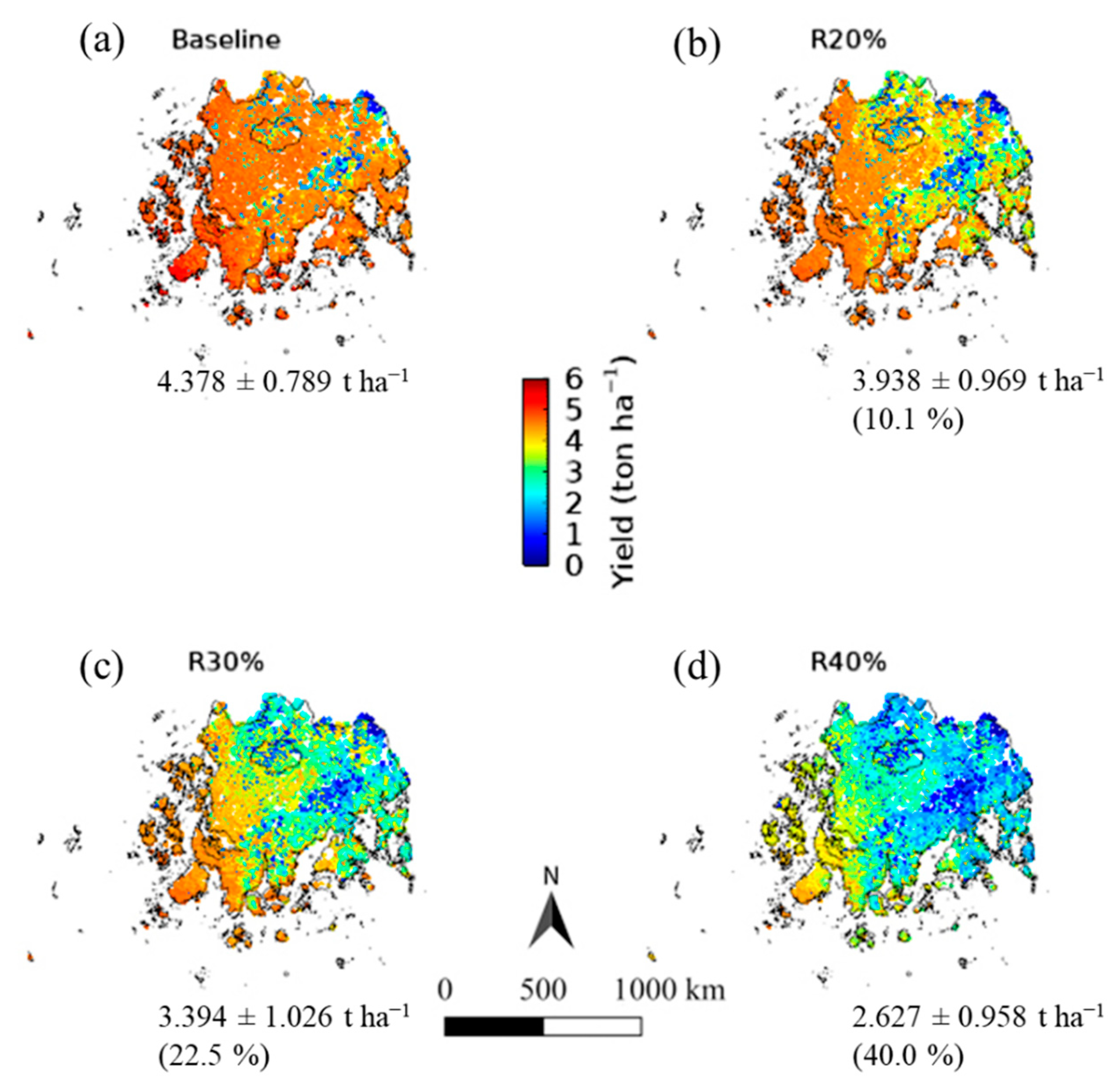
References
- Barron-Gafford, G.A.; Pavao-Zuckerman, M.A.; Minor, R.L.; Sutter, L.F.; Barnett-Moreno, I.; Blackett, D.T.; Thompson, M.; Dimond, K.; Gerlak, A.K.; Nabhan, G.P.; et al. Agrivoltaics provide mutual benefits across the food–energy–water nexus in drylands. Nat. Sustain. 2019, 2, 848–855. [Google Scholar] [CrossRef]
- Dupraz, C.; Marrou, H.; Talbot, G.; Dufour, L.; Nogier, A.; Ferard, Y. Combining solar photovoltaic panels and food crops for optimising land use: Towards new agrivoltaic schemes. Renew. Energy 2011, 36, 2725–2732. [Google Scholar] [CrossRef]
- AL-agele, H.A.; Proctor, K.; Murthy, G.; Higgins, C. A Case Study of Tomato (Solanum lycopersicon var. Legend) Production and Water Productivity in Agrivoltaic Systems. Sustainability 2021, 13, 2850. [Google Scholar] [CrossRef]
- Marrou, H.; Guilioni, L.; Dufour, L.; Dupraz, C.; Wery, J. Microclimate under agrivoltaic systems: Is crop growth rate affected in the partial shade of solar panels? Agric. For. Meteorol. 2013, 177, 117–132. [Google Scholar] [CrossRef]
- Cho, Y.; Kim, H.; Jo, E.; Oh, D.; Jeong, H.; Yoon, C.; An, K.; Cho, J. Effect of Partial Shading by Agrivoltaic Systems Panel on Electron Transport Rate and Non-photochemical Quenching of Crop. Korean J. Agric. For. Meteorol. 2021, 23, 100–107. [Google Scholar]
- Klerkx, L.; Begemann, S. Supporting food systems transformation: The what, why, who, where and how of mission-oriented agricultural innovation systems. Agric. Syst. 2020, 184, 102901. [Google Scholar] [CrossRef]
- de Boon, A.; Sandström, C.; Rose, D.C. Governing agricultural innovation: A comprehensive framework to underpin sustainable transitions. J. Rural. Stud. 2021, 23, 100–107. [Google Scholar] [CrossRef]
- Faria, J.R.; Mixon, F.G. Farmer-entrepreneurs, agricultural innovation, and explosive research and development cycles. Adm. Sci. 2016, 6, 13. [Google Scholar] [CrossRef] [Green Version]
- Yousefi-Babadi, A.; Bozorgi-Amiri, A.; Tavakkoli-Moghaddam, R. Sustainable facility relocation in agriculture systems using the GIS and best–worst method. Kybernetes 2021. ahead-of-print. [Google Scholar] [CrossRef]
- Lombardi, M.; Costantino, M. A Social Innovation model for reducing food waste: The case study of an Italian non-profit organization. Adm. Sci. 2020, 10, 45. [Google Scholar] [CrossRef]
- Dospinescu, N.; Dospinescu, O.; Tatarusanu, M. Analysis of the influence factors on the reputation of food-delivery companies: Evidence from Romania. Sustainability 2020, 12, 4142. [Google Scholar] [CrossRef]
- Ko, J.; Tim Ng, C.; Jeong, S.; Kim, J.-H.; Lee, B.; Kim, H.-Y. Impacts of regional climate change on barley yield and its geographical variation in South Korea. Int. Agrophysics 2019, 33, 81–96. [Google Scholar] [CrossRef]
- Lobell, D.B.; Schlenker, W.; Costa-Roberts, J. Climate Trends and Global Crop Production Since 1980. Science 2011, 333, 616–620. [Google Scholar] [CrossRef] [Green Version]
- Palosuo, T.; Hoffmann, M.P.; Rötter, R.P.; Lehtonen, H.S. Sustainable intensification of crop production under alternative future changes in climate and technology: The case of the North Savo region. Agric. Syst. 2021, 190, 103135. [Google Scholar] [CrossRef]
- Ko, J.; Kim, H.-Y.; Jeong, S.; An, J.-B.; Choi, G.; Kang, S.; Tenhunen, J. Potential impacts on climate change on paddy rice yield in mountainous highland terrains. J. Crop. Sci. Biotechnol. 2014, 17, 117–126. [Google Scholar] [CrossRef]
- Kim, H.Y.; Ko, J.; Kang, S.; Tenhunen, J. Impacts of climate change on paddy rice yield in a temperate climate. Glob. Chang. Biol. 2013, 19, 548–562. [Google Scholar] [CrossRef]
- Ahuja, L.R.; Rojas, K.W.; Hanson, J.D.; Shaffer, M.J.; Ma, L. Root Zone Water Quality Model: Modeling Management Effects on Water Quality and Crop Production; Water Resources Publications, LLC: Highland Ranch, CO, USA, 2000. [Google Scholar]
- Kirschbaum, M.U.F. Forest growth and species distribution in a changing climate. Tree Physiol. 2000, 20, 309–322. [Google Scholar] [CrossRef]
- McCown, R.L.; Hammer, G.L.; Hargreaves, J.N.G.; Holzworth, D.P.; Freebairn, D.M. APSIM: A novel software system for model development, model testing and simulation in agricultural systems research. Agric. Syst. 1996, 50, 255–271. [Google Scholar] [CrossRef]
- Brisson, N.; Gary, C.; Justes, E.; Roche, R.; Mary, B.; Ripoche, D.; Zimmer, D.; Sierra, J.; Bertuzzi, P.; Burger, P.; et al. An overview of the crop model stics. Eur. J. Agron. 2003, 18, 309–332. [Google Scholar] [CrossRef]
- Ma, L.; Hoogenboom, G.; Ahuja, L.; Nielsen, D.; Ascough, J. Development and evaluation of the RZWQM-CROPGRO hybrid model for soybean production. Agron. J. 2005, 97, 1172–1182. [Google Scholar] [CrossRef] [Green Version]
- Williams, J.R. The Erosion-Productivity Impact Calculator (EPIC) Model: A Case History. Philos. Trans. Biol. Sci. 1990, 329, 421–428. [Google Scholar]
- Hijmans, R.J.; Guiking-Lens, I.; Van Diepen, C. WOFOST 6.0: User’s Guide for the WOFOST 6.0 Crop Growth Simulation Model; DLO Winand Staring Centre: Wageningen, The Netherlands, 1994; p. 145. [Google Scholar]
- Jones, J.W.; Hoogenboom, G.; Porter, C.H.; Boote, K.J.; Batchelor, W.D.; Hunt, L.; Wilkens, P.W.; Singh, U.; Gijsman, A.J.; Ritchie, J.T. The DSSAT cropping system model. Eur. J. Agron. 2003, 18, 235–265. [Google Scholar] [CrossRef]
- Singh, U.; Ritchie, J.; Thornton, P. CERES-Cereal Model for Wheat, Maize, Sorghum, Barley, and Pearl Millet; Agronomy Abstracts: Madison, WI, USA, 1991; p. 78. [Google Scholar]
- Boote, K.J.; Jones, J.W.; Hoogenboom, G.; Pickering, N. Simulation of crop growth: CROPGRO model. Agric. Syst. Modeling Simul. 1998, 18, 651–692. [Google Scholar]
- Singh, U.; Matthews, R.B.; Griffin, T.S.; Ritchie, J.T.; Hunt, L.A.; Goenaga, R. Modeling growth and development of root and tuber crops. In Understanding Options for Agricultural Production; Tsuji, G.Y., Hoogenboom, G., Thornton, P.K., Eds.; Springer: Dordrecht, The Netherlands, 1998; pp. 129–156. [Google Scholar] [CrossRef]
- Kim, J.; Park, J.; Hyun, S.; Fleisher, D.H.; Kim, K.S. Development of an automated gridded crop growth simulation support system for distributed computing with virtual machines. Comput. Electron. Agric. 2020, 169, 105196. [Google Scholar] [CrossRef]
- Dinesh, H.; Pearce, J.M. The potential of agrivoltaic systems. Renew. Sustain. Energy Rev. 2016, 54, 299–308. [Google Scholar] [CrossRef] [Green Version]
- Thornley, J.H.; Johnson, I.R. Plant and Crop Modelling: A Mathematical Approach to Plant and Crop Physiology; Clarendon Press: Oxford, UK, 1990. [Google Scholar]
- Hong, S.Y.; Zhang, Y.-S.; Hyun, B.-K.; Sonn, Y.-K.; Kim, Y.-H.; Jung, S.-J.; Park, C.-W.; Song, K.-C.; Jang, B.-C.; Choe, E.-Y. An introduction of Korean soil information system. Korea J. Soil Sci. Fert. 2009, 42, 21–28. [Google Scholar]
- Harb, O.; Abd El-Hay, G.; Hager, M.; Abou El-Enin, M. Calibration and validation of DSSAT V. 4.6. 1, CERES and CROPGRO models for simulating no-tillage in Central Delta, Egypt. Agrotechnology 2016, 5, 2. [Google Scholar]
- Kim, H.-Y.; Ko, J.; Jeong, S.; Kim, J.-H.; Lee, B. Geospatial delineation of South Korea for adjusted barley cultivation under changing climate. J. Crop. Sci. Biotechnol. 2017, 20, 417–427. [Google Scholar] [CrossRef]
- Ahn, J.; Hur, J.; Shim, K. A simulation of agro-climate index over the Korean peninsula using dynamical downscaling with a numerical weather prediction model. Korean J. Agric. For. Meteorol. 2010, 12, 1–10. [Google Scholar] [CrossRef]
- Nash, J.E.; Sutcliffe, J.V. River flow forecasting through conceptual models part I—A discussion of principles. J. Hydrol. 1970, 10, 282–290. [Google Scholar] [CrossRef]
- Ko, J.; Ahuja, L.R.; Saseendran, S.; Green, T.R.; Ma, L.; Nielsen, D.C.; Walthall, C.L. Climate change impacts on dryland cropping systems in the Central Great Plains, USA. Clim. Chang. 2012, 111, 445–472. [Google Scholar] [CrossRef]
- Ko, J.; Ahuja, L.; Kimball, B.; Anapalli, S.; Ma, L.; Green, T.R.; Ruane, A.C.; Wall, G.W.; Pinter, P.; Bader, D.A. Simulation of free air CO2 enriched wheat growth and interactions with water, nitrogen, and temperature. Agric. For. Meteorol. 2010, 150, 1331–1346. [Google Scholar] [CrossRef]
- Ko, J.; Piccinni, G.; Steglich, E. Using EPIC model to manage irrigated cotton and maize. Agric. Water Manag. 2009, 96, 1323–1331. [Google Scholar] [CrossRef]
- Mauget, S.A.; Ko, J. A two-tier statistical forecast method for agricultural and resource management simulations. J. Appl. Meteorol. Climatol. 2008, 47, 1573–1589. [Google Scholar] [CrossRef]
- Shin, T.; Ko, J.; Jeong, S.; Shawon, A.R.; Lee, K.D.; Shim, S.I. Simulation of Wheat Productivity Using a Model Integrated With Proximal and Remotely Controlled Aerial Sensing Information. Front. Plant Sci. 2021, 12, 446. [Google Scholar] [CrossRef] [PubMed]
- Rosenzweig, C.; Elliott, J.; Deryng, D.; Ruane, A.C.; Müller, C.; Arneth, A.; Boote, K.J.; Folberth, C.; Glotter, M.; Khabarov, N.; et al. Assessing agricultural risks of climate change in the 21st century in a global gridded crop model intercomparison. Proc. Natl. Acad. Sci. USA 2014, 111, 3268–3273. [Google Scholar] [CrossRef] [Green Version]
- Jeong, S.; Ko, J.; Kang, M.; Yeom, J.; Ng, C.T.; Lee, S.-H.; Lee, Y.-G.; Kim, H.-Y. Geographical variations in gross primary production and evapotranspiration of paddy rice in the Korean Peninsula. Sci. Total. Environ. 2020, 714, 136632. [Google Scholar] [CrossRef]
- Huang, J.; Gómez-Dans, J.L.; Huang, H.; Ma, H.; Wu, Q.; Lewis, P.E.; Liang, S.; Chen, Z.; Xue, J.-H.; Wu, Y.; et al. Assimilation of remote sensing into crop growth models: Current status and perspectives. Agric. For. Meteorol. 2019, 276–277, 107609. [Google Scholar] [CrossRef]
- Armstrong, A.; Ostle, N.J.; Whitaker, J. Solar park microclimate and vegetation management effects on grassland carbon cycling. Environ. Res. Lett. 2016, 11, 074016. [Google Scholar] [CrossRef] [Green Version]
- Kim, S.; Kim, S.; Yoon, C.-Y. An efficient structure of an agrophotovoltaic system in a temperate climate region. Agronomy 2021, 11, 1584. [Google Scholar] [CrossRef]
- Corporation, K.E.P. A Price of the System Marginal Price. Available online: https://home.kepco.co.kr/kepco/main.do (accessed on 9 December 2021).
- Exchange, K.P. A Price of the Renewable Energy Certificate. Available online: https://onerec.kmos.kr/portal/index.do (accessed on 9 December 2021).
- Lövenstein, H.; Rabbinge, R.; van Keulen, H. World Food Production, Textbook 2: Biophysical Factors in Agricultural Production; Wageningen University & Research: Wageningen, The Netherlands, 1992. [Google Scholar]
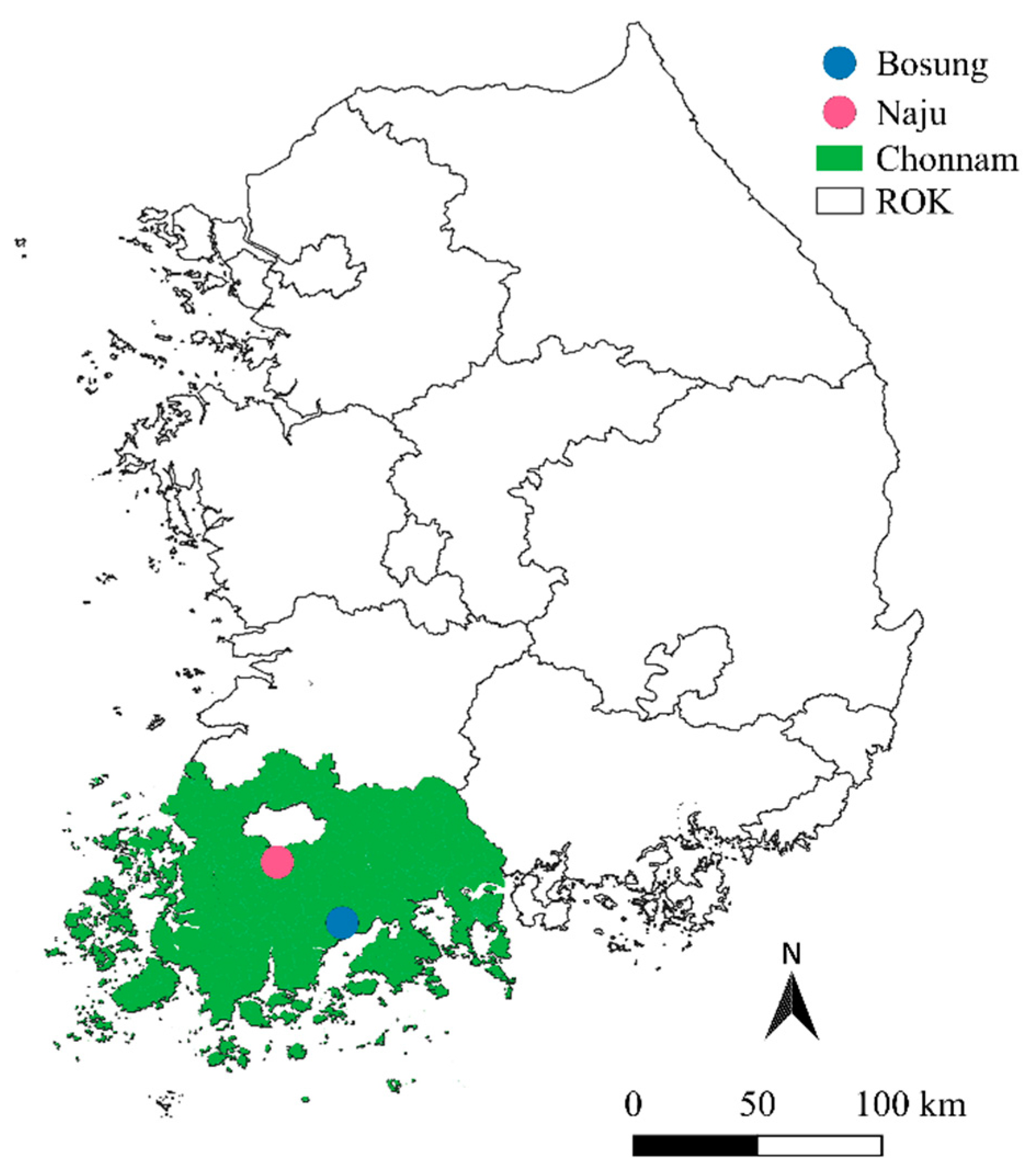

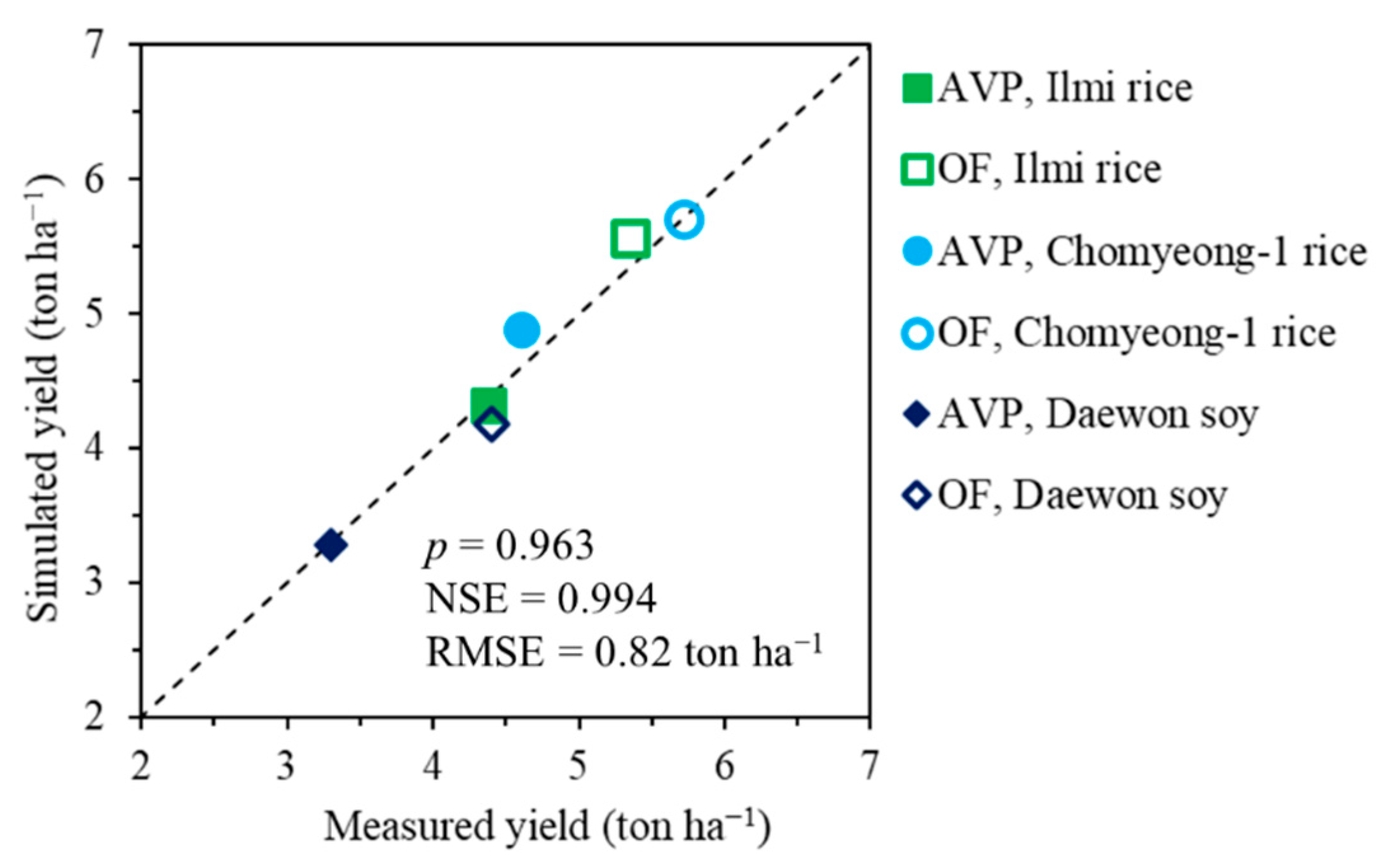
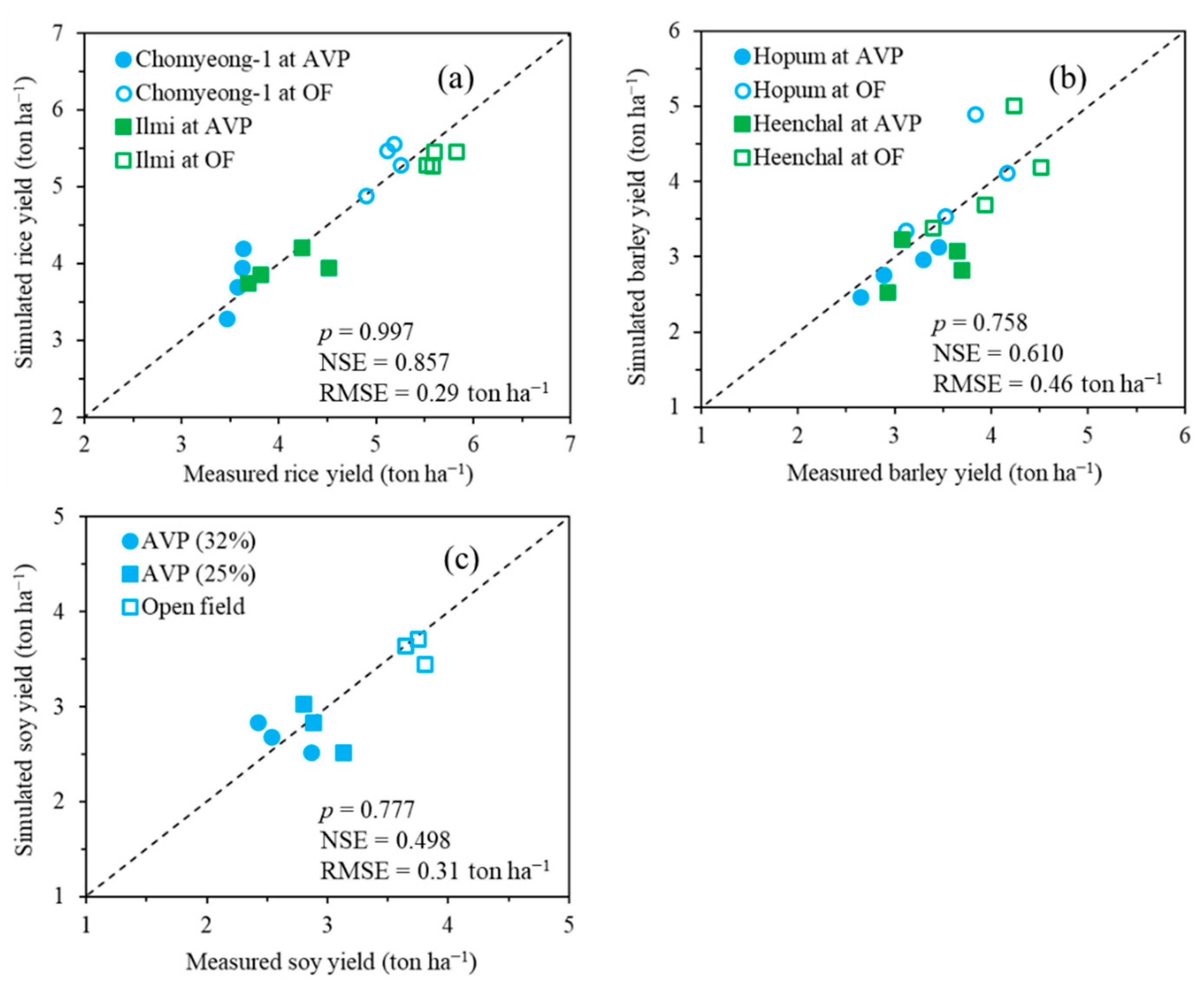


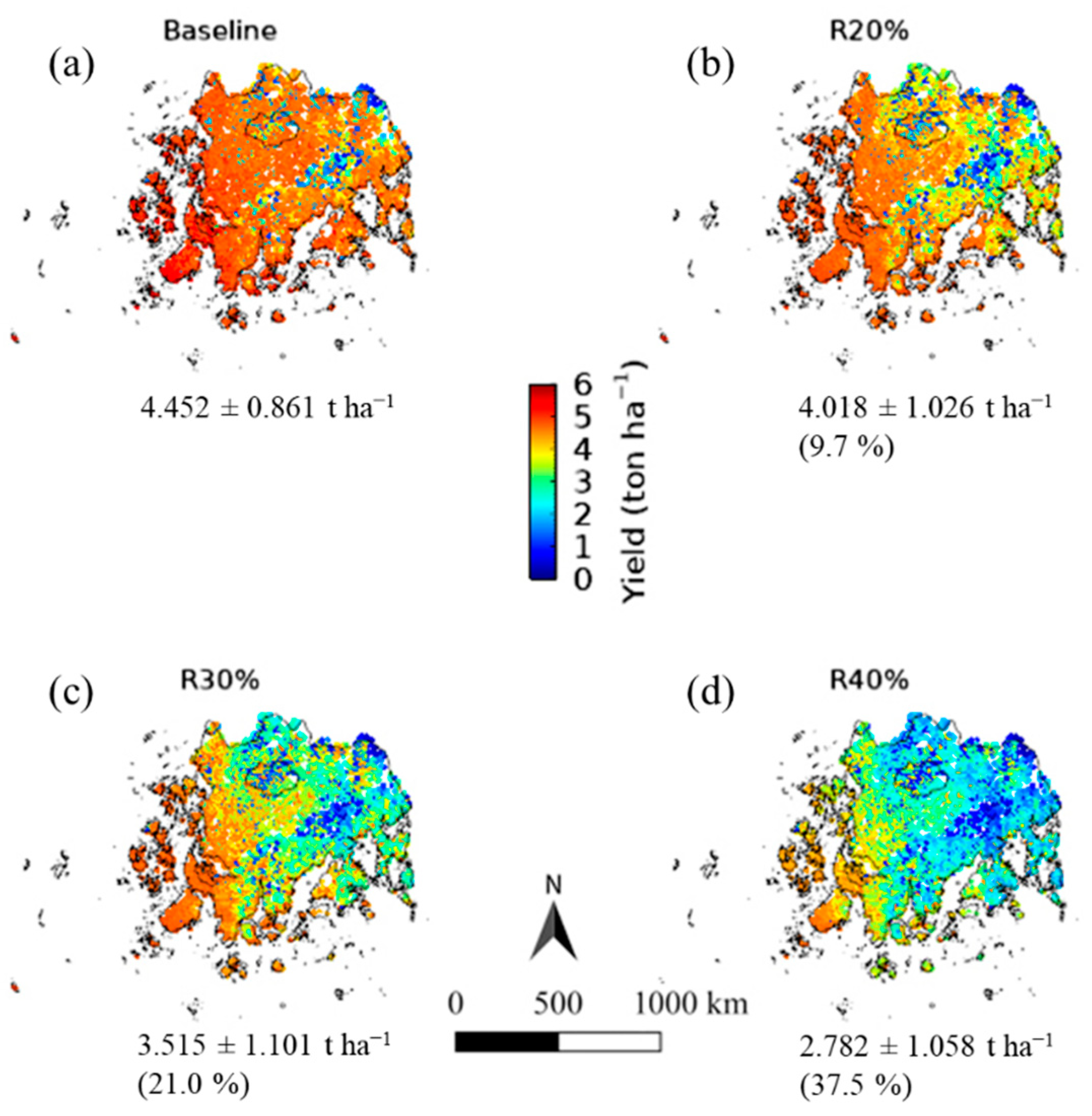

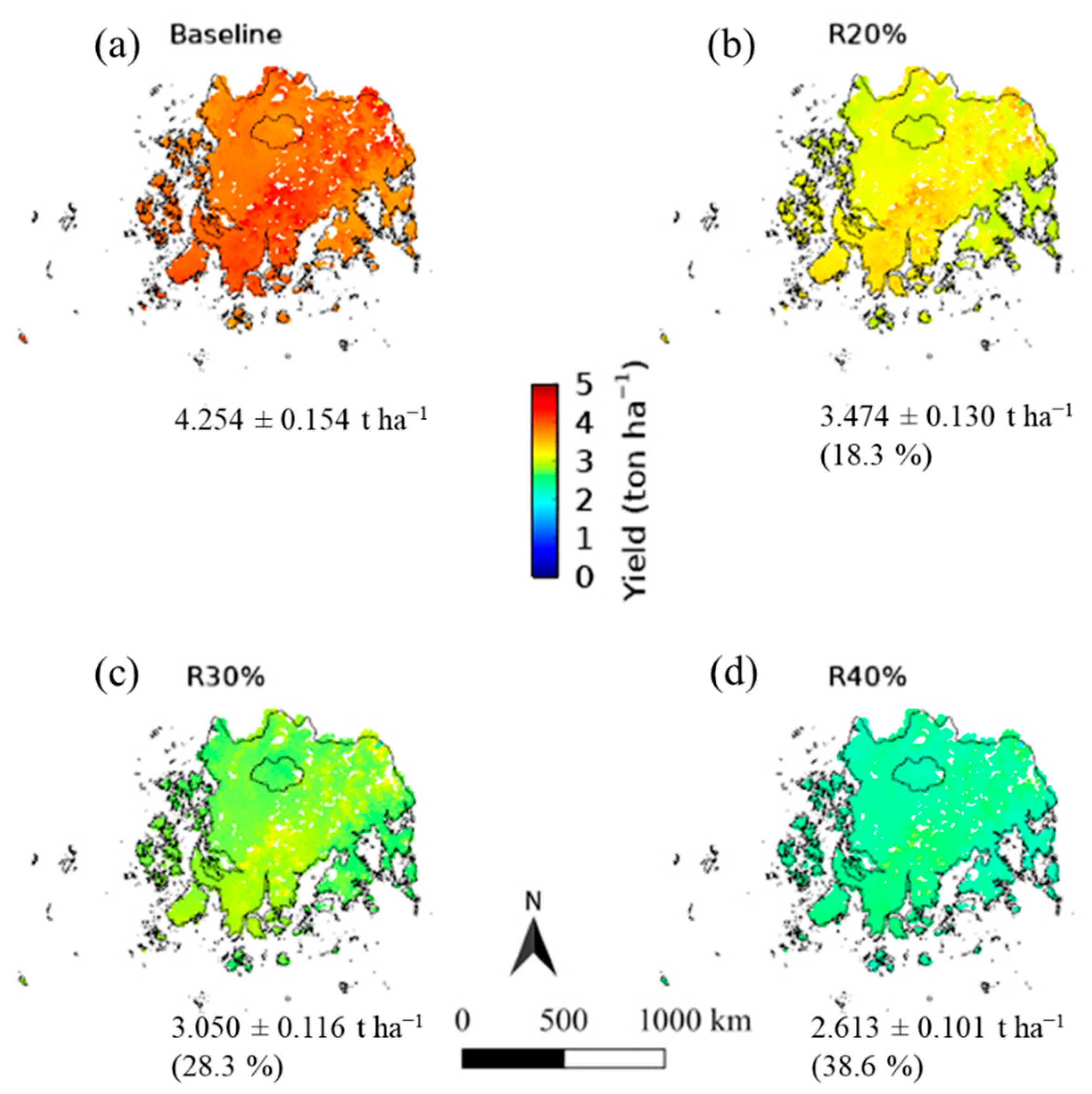
| Soil ID | Texture | Depth (cm) | Albedo | Drainage Rate (Fraction Day−1) | Soil Water † (cm3 cm−3) | |
|---|---|---|---|---|---|---|
| CLL | DUL | |||||
| IB00000002 | Medium silty clay | 150 | 0.11 | 0.2 | 0.228 | 0.385 |
| IB00000003 | Shallow silty clay | 60 | 0.11 | 0.1 | 0.228 | 0.385 |
| IB00000005 | Medium silty loam | 150 | 0.12 | 0.3 | 0.108 | 0.218 |
| IB00000006 | Shallow silty loam | 60 | 0.12 | 0.2 | 0.108 | 0.218 |
| IB00000008 | Medium sandy loam | 150 | 0.13 | 0.5 | 0.052 | 0.176 |
| IB00000009 | Shallow sandy loam | 60 | 0.13 | 0.4 | 0.052 | 0.176 |
| IB00000011 | Medium sand | 150 | 0.15 | 0.5 | 0.024 | 0.096 |
| IB00000012 | Shallow sand | 60 | 0.15 | 0.4 | 0.024 | 0.096 |
Publisher’s Note: MDPI stays neutral with regard to jurisdictional claims in published maps and institutional affiliations. |
© 2021 by the authors. Licensee MDPI, Basel, Switzerland. This article is an open access article distributed under the terms and conditions of the Creative Commons Attribution (CC BY) license (https://creativecommons.org/licenses/by/4.0/).
Share and Cite
Ko, J.; Cho, J.; Choi, J.; Yoon, C.-Y.; An, K.-N.; Ban, J.-O.; Kim, D.-K. Simulation of Crop Yields Grown under Agro-Photovoltaic Panels: A Case Study in Chonnam Province, South Korea. Energies 2021, 14, 8463. https://doi.org/10.3390/en14248463
Ko J, Cho J, Choi J, Yoon C-Y, An K-N, Ban J-O, Kim D-K. Simulation of Crop Yields Grown under Agro-Photovoltaic Panels: A Case Study in Chonnam Province, South Korea. Energies. 2021; 14(24):8463. https://doi.org/10.3390/en14248463
Chicago/Turabian StyleKo, Jonghan, Jaeil Cho, Jinsil Choi, Chang-Yong Yoon, Kyu-Nam An, Jong-Oh Ban, and Dong-Kwan Kim. 2021. "Simulation of Crop Yields Grown under Agro-Photovoltaic Panels: A Case Study in Chonnam Province, South Korea" Energies 14, no. 24: 8463. https://doi.org/10.3390/en14248463






